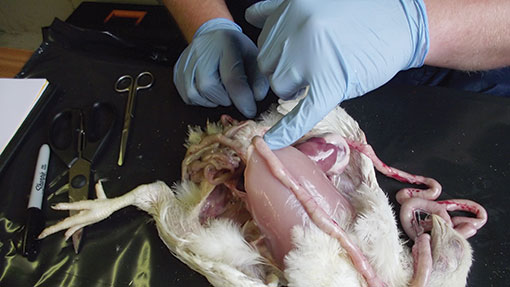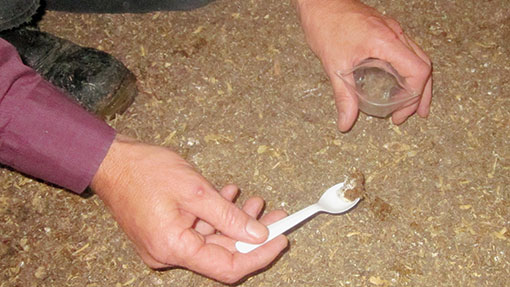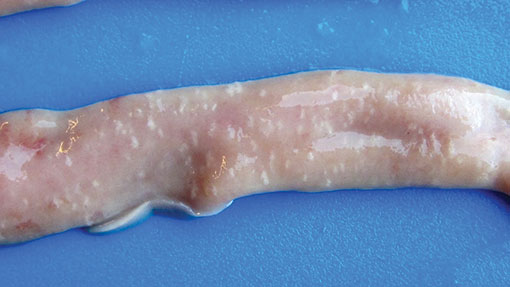On-farm trials support coccidiosis vaccination

In the second of a three-part series on Enteric Health sponsored by MSD Animal Health, we take a more detailed look at the company’s trials into using vaccination as an alternative means of controlling coccidiosis in commercial broiler flocks.
During the past two years MSD Animal Health has been investigating how using a live attenuated vaccine can help broiler producers control coccidiosis and improve flock health.
The project has involved more than 7.5 million broilers to date and MSD says the ongoing investigation is demonstrating that vaccination can offer producers some key benefits, both clinically and economically.
The programme begins in the hatchery with day-old chicks spray-vaccinated with Paracox-5 (POM-VPS). This live, attenuated vaccine induces immunity against the five strains of coccidia affecting broilers: Eimeria acervulina, E maxima (two strains), E mitis, and E tenella. The birds are then monitored throughout the rearing process until depletion.
Andy Payne, MSD’s Paracox 5 trials assistant, co-ordinates the project. Apart from helping to set up and audit hatchery vaccination procedures, he also monitors the flocks at specific ages during the production cycle. The chickens are assessed and findings are recorded to determine the level of disease challenge within the flock. Observations are also made on general broiler health and productivity.
The data collected is primarily used to gauge the efficacy of the vaccine. However, it also provides MSD, farm managers and the integrators with key information about the health status of their flocks and how it might be affecting growth and uniformity.
“All of the farm managers involved say they are pleased with the coccidiosis control since using the vaccine, and have seen some improvements in other areas as well,” says Mr Payne. “The feedback is positive and many managers are now focusing their resources on other aspects of the production system, for example ventilation and drinker management, and this is benefiting productivity and margins.”
He also suggests that the overall gut integrity of flocks has improved. Post-mortem examinations of the digestive tracts of vaccinated broilers consistently show a healthy gut wall, with minimal evidence of coccidial infection. Such characteristics contribute to bird health and performance, and can allow producers to use less expensive diets with a higher whole wheat content during the later stages of the growing period.

Faecal samples are taken to measure oocyst numbers.
Samples of droppings are taken at 15 days of age, with collections repeated every three or four days to count oocyst numbers (measured as oocysts per gram of faeces – OPG). Lesion scores at 21 and 28 days of age are also recorded to establish coccidial activity in the intestine.
The information builds a disease profile for each crop of birds, and reveals what species are present at these specific times. It provides key information on how vaccination is working, and when referenced against practical observations and performance data, offers a valuable insight into flock health and productivity.
“The information I collect helps to establish the peak periods of coccidiosis challenge,” says Mr Payne. “Different eimeria species affect the birds at different times, with lesions evident in specific areas of the gut. By monitoring the broilers and liaising with the farms’ vets, we aim to build a clearer picture of what is happening on the farms, as well as making sure that the vaccine is working effectively.
“I expect to see mild evidence of Eimeria acervulina in the small intestine at day 20 to 22. I’m also looking for signs of E tenella in the caeca, but this is rare. By day 28 the E acervulina associated lesions will have disappeared, but there could be some evidence of E maxima in the gut wall, further down the digestive tract. These lesions are typically mild in Paracox-5 vaccinated flocks,” he explains.
Data analysis
The lesion scores, OPG results and clinical observations for every farm are recorded on MSD’s database. Initial observations show consistently low lesion scores from most of the trial sites, suggesting that the broilers are developing a strong immunity against coccidiosis, the vaccine is effective and the disease is being controlled.
The individual information collected from each farm is shared with the farm’s manager, their respective vets and the integrator.
Sampling birds offers a good opportunity to observe general health status and examine gut function. The viscosity of the gut content and the physical condition of intestinal wall can often indicate a disease challenge before any clinical signs appear in the flock.

Intestinal lessions that indicate an E acervulina challenge.
“If gut content appears watery and/or looks unusual, then I will inform the manager, who then contacts their vet. Having this information means vets and managers can take immediate action to head off a potential problem,” he adds.
These trials are also helping producers to focus attention on improving their overall flock management.
“Many factors influence broiler health and performance, but management has the greatest impact. The Paracox-5 project has definitely added another dimension to how broilers are managed on the trial farms, with producers now having a greater understanding of enteric health and why gut integrity is so important,” says Mr Payne.
MSD says the past two years of studies show that the performance parameters and financial margins of Paracox-5 vaccinated flocks are comparable to flocks on in-feed anti-coccidials and in some cases even better. Also, the information collected from this project does not indicate any increased incidence of necrotic enteritis in vaccinated flocks, contrary to what many producers feared might happen before the trials began.
Developing an overall strategy
Production teams must recognise that achieving the maximum benefit from a coccidiosis vaccination programme takes time.
Improvements are unlikely to be seen initially, as most farms have to work through the process a few times before they begin to realise the long-term benefits of coccidiosis vaccination.
A number of MSD’s trial farms have used additional anti-coccidial treatments under veterinary guidance in crops reared preceding an intake of vaccinated birds. They have also used additional disinfectants with oocidal properties.
This strategy has proved successful and has helped to reduce the “carryover” effect from one crop to the next. However, coccidia are persistent and poultry producers must understand that, until the populations of field strains in the environment are outnumbered by vaccine derived strains, then they may continue to see some evidence of infection within their first few crops of vaccinated birds.
“Although the Paracox-5 vaccine is highly effective and induces a strong immune response, it usually takes two or three crops of birds before improvements can be seen,” says Dr Tibor Cserep, technical manager with MSD’s poultry team. “But this is purely due to the nature of the parasite we are dealing with. Coccidia are tough, resilient and extremely persistent. A field challenge always exists and these strains take time to displace.”
He says there is a “buy-in” period associated with a coccidiosis vaccination strategy, but once the programme is established, then flock health really does start to improve.
Project pointers
- The Paracox-5 vaccination programme begins in the hatchery. Day-old chicks are sprayed with the vaccine before delivery to the broiler farms.
- MSD supplies the vaccination equipment to hatcheries involved in the project and commissions every machine used; there are currently seven in operation.
- The MSD poultry team also provides a comprehensive, on-going training and support package to ensure operators understand how to prepare the vaccine and apply it effectively. It also audits the vaccination routines at least every six months to ensure quality control and update any skills training/technical support requirements.
- The emphasis is on achieving consistent, uniform vaccine application that will optimise uptake by the birds and produce a strong immune response.
- Broiler growers are encouraged to work with their vets to develop optimum biosecurity and hygiene protocols. The farms must implement thorough cleaning and disinfection during the rest period before a new intake of vaccinated chicks is placed. This minimises “carryover” of coccidiosis infection from one crop to another.
Sponsor’s message
MSD Animal Health manufactures and supplies a range of products to tackle some common intestinal health problems:
- Paracox 5: live coccidial vaccine which protects against coccidiosis caused by the main eimeria species affecting broilers
- Paracox 8: live coccidial vaccine which protects against coccidiosis caused by the main eimeria species affecting layers and broiler breeders
- Aviguard: freeze dried natural gut flora to seed the gut with “good” bacteria before periods of stress or after the use of antibiotics
The MSD team is available for assistance and advice with the implementation of vaccination and intestinal health programmes for vets and producers. You can contact the team via our veterinary support group on 01908 685 685.

MSD products are mainly prescription only medications and are provided via your veterinary surgeon.
